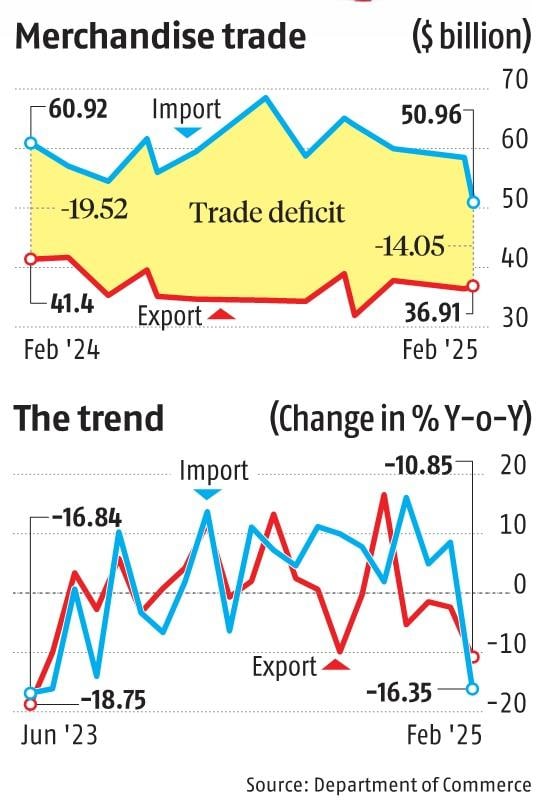NEW DELHI: India’s merchandise trade deficit plummeted to a three-and-a-half-year low of $14.05 billion in February, as exports and imports saw a sharp contraction due to softening global petroleum prices and rising economic uncertainty amid restrictive trade practices by the United States.
The trade deficit — the gap between imports and exports — stood at $19.52 billion in February 2024.
Data released by the Commerce Department on Monday showed outbound shipments from India contracted at the sharpest pace in 20 months, falling 10.9 per cent year-on-year to $36.91 billion in February. However, officials said the decline in exports could also be attributed to a high base of $41.4 billion in the same period a year ago.
Imports fell 16.3 per cent to $50.96 billion — the most significant decline in 20 months and the first drop in 11 months — driven largely by a 29.6 per cent fall in oil imports to $11.9 billion. Gold imports also tumbled 62 per cent to $2.3 billion.
The outlook for India’s merchandise exports remains uncertain due to the looming threat of reciprocal tariffs the US plans to impose on trading partners starting April 2. The US has already levied a 25 per cent duty on steel and aluminium imports. Exporters also report a troubling trend of American importers holding back orders in anticipation of further tariffs.
India’s export contraction stood out among other emerging market economies.
China, the world’s largest trading nation, saw exports rise 7.1 per cent in January-February 2025, while Vietnam’s outbound shipments climbed 8.4 per cent over the same period.
On a cumulative basis, India’s merchandise exports were flat at $395 billion in the first 11 months of the current financial year.
Commerce Secretary Sunil Barthwal said that despite challenges in FY25, the country is on track to reach $800 billion in combined exports of goods and services. In the previous financial year, India exported and imported goods and services worth $778 billion.
Non-petroleum and non-gems-and-jewellery exports — often viewed as a clearer gauge of export health — fell nearly 5 per cent to $28.57 billion in February. Key sectors that saw declines included gems and jewellery (-20.7 per cent), drugs and pharmaceuticals (-1.5 per cent), organic and inorganic chemicals (-24.5 per cent), petroleum products (-29.2 per cent), and engineering goods (-8.6 per cent). However, exports of rice (13.2 per cent), electronic goods (26 per cent), and readymade garments (4 per cent) posted gains.
Aditi Nayar, chief economist at ICRA, said the decline in India’s trade deficit to a 42-month low explained from a sharp contraction in crude oil, gold, and silver imports. “A portion of the year-on-year decline in merchandise exports can be attributed to the base-year effect related to the leap month. The trade deficit was also significantly lower than the average of over $23 billion during the first 10 months of FY25. Given this print, we now expect the current account to post a surplus of about $5 billion in Q4FY25, equivalent to roughly 0.5 per cent of GDP,” she said.
Federation of Indian Export Organisations (FIEO) President Ashwani Kumar said that while exports have faced challenges, particularly from the global tariff war, the sharp drop in imports signals weaker demand for foreign goods, which could create opportunities for domestic industries.
“A concerted effort is needed to revitalise export growth, particularly through targeted initiatives that enhance India’s global competitiveness,” Kumar said, adding that a focused approach is required to diversify exports, explore new markets and products, and maintain trade facilitation measures.
Services exports rose 23.6 per cent to $35.03 billion in February, while services imports climbed 8.6 per cent to $16.55 billion, resulting in a surplus of $18.5 billion. However, the February services trade data is an “estimate” and will be revised following the Reserve Bank of India’s subsequent release.
Source: Business Standard




 India, New Zealand Explore Digital Payments, Trade, And Investment Ties
India, New Zealand Explore Digital Payments, Trade, And Investment Ties 